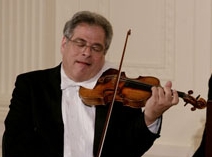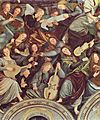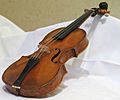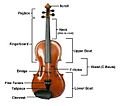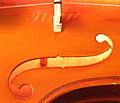Violin facts for kids
The violin is a string instrument with four strings. You play it with a special stick called a bow. The strings are usually tuned to the musical notes G, D, A, and E. You hold the violin between your left collar bone (near your shoulder) and your chin.
To make different notes, you press on the strings with your left hand. This is called "fingering." At the same time, you move the bow with your right hand. Unlike a guitar, a violin does not have frets or other markers on its fingerboard.
The violin is the smallest string instrument often used in Western music. It also makes the highest sounds. A person who plays the violin is called a violinist. Someone who builds or fixes violins is called a luthier.
The violin is very important in European and Arabian music. It has played a huge part in music history. The modern violin is about 400 years old. But similar string instruments have been around for almost 1000 years. By the 1600s, when modern orchestras began, the violin was almost fully developed. It became the most important instrument in an orchestra. Almost half of the instruments in an orchestra are violins. They are split into "first violins" and "second violins." Many composers wrote music for the violin. This includes music for a solo player, small groups (like chamber music), orchestras, folk music, and even jazz.
Sometimes, the violin is called a “fiddle”. A person who plays it is a “fiddler.” To "fiddle" means to play the fiddle. This nickname is often used when talking about folk music.
Contents
History of the Violin

The word “violin” is connected to the word “viol.” The violin did not come directly from instruments called viols. The word violin comes from an old Latin word, vitula. This means stringed instrument. This old word is also thought to be where the Germanic word “fiddle” came from.
The modern European violin slowly changed over time. It developed from many different bowed string instruments. These instruments came from the Middle East and the Byzantine Empire. It is likely that the first violin makers got ideas from three instruments. These were the rebec, used since the 900s, the Renaissance fiddle, and the lira da braccio. These instruments were held under the chin and played with a bow.
In the 1600s, there were several families of luthiers who were very skilled. They made amazing instruments. The most famous violin makers were Stradivarius, Amati, and Guarneri. Some of the violins these luthiers made are still around today. They are kept in museums worldwide. These are some of the best instruments ever made. They can be worth over a million dollars.
How Violins Are Made
The biggest part of the violin is its wooden body. This body acts like a sound box. It makes the vibrating strings sound much louder. Many parts of the violin are named after parts of the human body. The front is called the “belly.” The back is called the “back.” The sides are the “ribs.”
The strings go from near the top of the “neck” down the “fingerboard.” Then they go onto the “tail piece.” The strings cross over the bridge. The bridge is about halfway between the end of the fingerboard and the tailpiece. The bridge is not glued to the violin. It stays in place because the strings are pulled so tightly. If the strings are completely loose, the bridge will fall off. The bridge helps send the string vibrations to the violin's body.
Inside the body, there is a “soundpost.” This is a small piece of wood. It looks like a small finger. It goes from the belly to the back. The soundpost is also held in place by the tight strings. In the middle of the belly, there are two long, curved holes. They are called “f holes” because of their shape.
The top of the strings are wrapped around pegs. You can tune the violin by turning these pegs. The very top of the neck is called the scroll. Today, violins also have a chinrest. This helps you hold the violin against your shoulder. A shoulder rest can also be used. These are now made of foam. They have special legs to attach them to the violin. Many beginners use a sponge and an elastic band instead.
To make tuning easier, many players use “adjusters” for “fine tuning.” These are used when a string is only a little bit out of tune. These adjusters go through holes in the tailpiece. They help stop the strings from slipping when you tune them.
Strings used to be made from animal gut. Now, they are mostly made of steel or nylon. Adjusters can only be used with certain types of strings. The front of the violin body is made of spruce wood. The back and sides are made of maple wood. The bow can be made of different kinds of wood. An example is pernambuco. Some players now use bows made of carbon fiber. The bow is strung with horsehair. This hair comes from the horse's mane or tail.
How to Play the Violin
It takes many years of practice to become a good violinist. A beginner will start with simple songs or exercises. These do not need very exact or complex movements of the hands. Examples of simple songs include Twinkle Twinkle Little Star and Over the Rainbow. While playing these "simple" songs, the violinist learns basic skills. These include how to hold the bow and the violin correctly. As the musician gets more confident and skilled, the songs and exercises become harder. They also learn new techniques to improve their playing. These include vibrato, smooth bow changes, and shifting hand positions.
The violinist must learn to place their fingers in exactly the right spot. This makes sure the music is “in tune.” This is called intonation. Musicians also learn vibrato. This makes each note sound slightly higher, then slightly lower. It creates a gentle wavering sound. This is important in many music styles to create a certain mood.
Besides plucking the strings (pizzicato), there are many special effects. Some of these are glissando (sliding notes), portamento (smoothly connecting notes), and harmonics (lightly touching strings to make high, clear sounds). There is also double stopping (playing two strings at once), chords (playing three or four strings at once), and scordatura tuning (changing the usual string tuning).
You can play the violin either standing or sitting. When playing solo music, violinists usually stand. When playing in chamber music or orchestras, violinists usually sit. However, this was not always the case. When sitting, a violinist might need to turn their right leg inward. This stops it from getting in the way of the bow.
Violin Music
In the 1600s and 1700s, composers wrote a lot of music for solo violin. Many of these composers were from Italy. They were violinists themselves. Some famous Italian violinists include Corelli, Vitali, Vivaldi, Veracini, Geminiani, Locatelli, and Tartini. In Germany, Schmelzer and Biber wrote very virtuoso (difficult and showy) violin music. Later, in the early 1700s, Bach and Handel wrote many masterpieces for the violin.
During the Classical music period, great composers like Haydn, Mozart, and Beethoven all wrote solo pieces for the violin. They also wrote a lot of chamber music, especially string quartets (music for two violins, a viola, and a cello).
In the Romantic period, many virtuoso violin pieces were written. These include concertos (pieces for solo instrument and orchestra) by Mendelssohn, Saint-Saëns, Brahms, Bruch, Wieniawski, Tchaikovsky, and Dvořák. In the 1900s, many more virtuoso works were written. These include pieces by Elgar, Sibelius, Szymanowski, Bartók, Stravinsky, Berg, Prokofiev, Shostakovich, Hindemith, and Penderecki.
In the 1800s, Niccolò Paganini was the most famous violinist. He wrote and played violin music that was harder than anything before. People even compared him to the devil. This was because he played so brilliantly and moved in strange ways.
In recent years, the violin has also been used in jazz music. Stéphane Grappelli was especially famous for his jazz violin playing.
Famous Violinists
Some of the most famous violinists from the last century include Fritz Kreisler, Jascha Heifetz, David Oistrakh, Yehudi Menuhin, Ida Haendel, and Isaac Stern. Today, some of the greatest players are Itzhak Perlman, Maxim Vengerov, Vadim Repin, Nigel Kennedy, Hilary Hahn, Joshua Bell, and fiddler Sara Watkins.
Related pages
Images for kids
-
The cupola of Madonna dei Miracoli in Saronno, Italy, with angels playing violin, viola and cello, from 1535. This is one of the earliest pictures of the violin family.
-
A close-up of a violin tailpiece, with a fleur-de-lis design.
-
Eric Stanley performing at TEDx Richmond, 2013.
-
The fiddler Hins Anders Ersson, painted by Anders Zorn in 1904.
See also
 In Spanish: Violín para niños
In Spanish: Violín para niños


